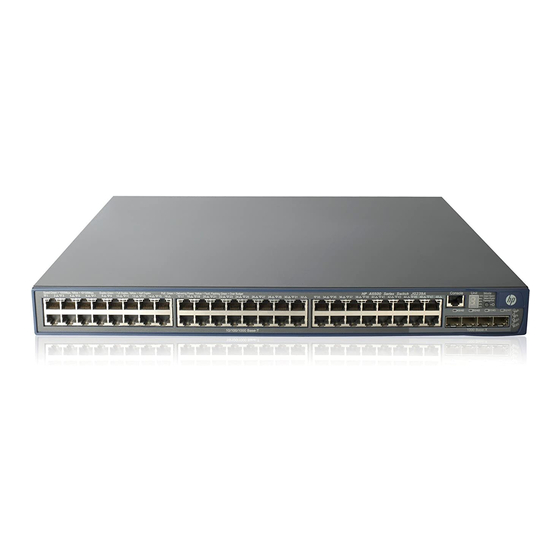HP 5500-24G-SFP EI TAA Quickspecs - Strona 6
Przeglądaj online lub pobierz pdf Quickspecs dla Przełącznik HP 5500-24G-SFP EI TAA. HP 5500-24G-SFP EI TAA 35 stron. Hp 5500 hi switch series
Również dla HP 5500-24G-SFP EI TAA: Specyfikacje (47 strony), Instrukcje demontażu produktu po zakończeniu eksploatacji (4 strony)

QuickSpecs
Overview
allows automatic learning and dynamic assignment of VLANs
IP multicast snooping and data-driven IGMP
automatically prevents flooding of IP multicast traffic
Internet Group Management Protocol (IGMP) and Multicast Listener Discovery (MLD) protocol snooping
controls and manages the flooding of multicast packets in a Layer 2 network
32K MAC addresses
provide access to many Layer 2 devices
IEEE 802.1ad QinQ and selective QinQ
increase the scalability of an Ethernet network by providing a hierarchical structure; connect multiple LANs on a high-speed
campus or metro network
10GbE port aggregation
allows grouping of ports to increase overall data throughput to a remote device
Spanning Tree/MSTP, RSTP, and STP root guard
prevent network loops
32 MSTP instances
allow multiple configurations of STP per VLAN group
Layer 3 services
Loopback interface address
defines an address in Routing Information Protocol (RIP) and Open Standard Path First (OSPF), improving diagnostic capability
Address Resolution Protocol (ARP)
determines the MAC address of another IP host in the same subnet; supports static ARPs; gratuitous ARP allows detection of
duplicate IP addresses; proxy ARP allows normal ARP operation between subnets or when subnets are separated by a Layer 2
network
Dynamic Host Configuration Protocol (DHCP)
simplifies the management of large IP networks and supports client and server; DHCP Relay enables DHCP operation across
subnets
User Datagram Protocol (UDP) helper function
allows UDP broadcasts to be directed across router interfaces to specific IP unicast or subnet broadcast addresses and prevents
server spoofing for UDP services such as DHCP
Layer 3 routing
IPv4 routing protocols
support static routes, RIP, OSPF, ISIS, and BGP
IPv6 routing protocols
provide routing of IPv6 at wire speed; support static routes, RIPng, OSPFv3, IS-ISv6, and BGP4+ for IPv6
PIM-SSM, PIM-DM, and PIM-SM (for IPv4 and IPv6)
support IP Multicast address management and inhibition of DoS attacks
MPLS support
provides extended support of MPLS, including MPLS VPNs and MPLS Traffic Engineering (MPLS TE)
Virtual Private LAN Service (VPLS)
establishes point-to-multipoint Layer 2 VPNs across a provider network
Bidirectional Forwarding Detection (BFD)
enables link connectivity monitoring and reduces network convergence time for RIP, OSPF, BGP, IS-IS, VRRP, MPLS, and IRF
Policy-based routing
makes routing decisions based on policies set by the network administrator
Equal-Cost Multipath (ECMP)
enables multiple equal-cost links in a routing environment to increase link redundancy and scale bandwidth
DA - 14201 Worldwide — Version 20 — April 15, 2014
HP 5500 HI Switch Series
Page 6
